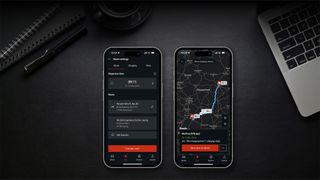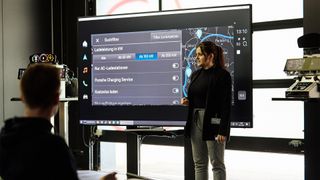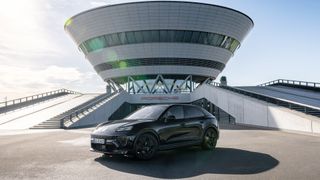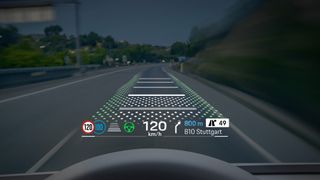Inside the new Porsche Macan – the Android-powered EV that’s taking the fight to Tesla
I was among a handful of journalists whom Porsche recently invited to its production plant in Leipzig, Germany, to sniff around the new Panamera and get a taste of what we can expect from the upcoming Macan – the first of its kind to be offered in EV guise only.
Although only revealed this day in heavily disguised prototype form, we have learned that this high-performance, high-performance electric SUV will be underpinned by the latest Premium Platform Electric architecture (developed in collaboration with Audi) and powered by permanently controlled synchronous electric motors. (PSM) and features 800 volt fast charging technology.
All models will have lithium-ion batteries at the bottom with a total capacity of around 100 kWh, while the punchiest Macan EVs will develop around 450 kW (603 hp in old money) and more than 1,000 Nm of torque.
Ignore the distinct lack of raspy engine noise for a moment, and believe me when I say it will be ridiculously fast, ridiculously capable off-road and embody everything Porsche stands for when it comes to handling and performance. The driver who rearranged my internal organs on the Porsche test track confirmed all that.
But it's in the new Macan that some of the biggest – and perhaps most unsung – changes have taken place.
Ultra-fast substantiation
Like the upcoming Panamera and Taycan, the Macan EV will feature a 12.6-inch, fully digital and free-standing curved display that displays key vehicle information. In addition, there is a full HD 10.9-inch touchscreen for infotainment and the option for the front passenger to enjoy an additional 10.9-inch touchscreen.
Thanks to a special film overlaying that display, it is possible for the front occupant to watch box sets and update social channels without distracting the driver.
“The biggest change for us is how quickly this new system responds,” Miriam Mohamad, Project Manager Digital for Macan, told me at the event.
“The entire system is supported by new Qualcomm processors, allowing the system to respond quickly, while we have significantly improved the effectiveness of our voice assistant,” she adds.
This was nicely demonstrated when Mohamad had her colleague Joan Pieper start chatting in the background while she gave a series of 'Hey Porsche' voice commands.
Not only could the new dual microphone system determine who was barking the important instructions, visually display seat recognition on the central screen and indicate interaction via 56 twinkling LEDs running across the instrument panel, it also processed these instructions quickly.
“The voice assistant can now handle more conversational language and can handle more specific requests, such as finding a charging point from a particular supplier,” Mohamad adds.
In addition, this new, fast system was used to calculate complex theoretical routes throughout Europe, taking into account multiple charging stops along the way. Even the longest journeys took just a few seconds to process and display, with the ability to quickly send pre-programmed routes from Porsche's smartphone app when you're not in the car.
Android raises the bar
Porsche has turned to Android Automotive to provide the operating system that powers its latest infotainment offering, and this gives owners the option to tap into an extensive app store, rather than relying on something Porsche has developed and put together.
The system is just as fast and starts up in the background as the driver approaches with the key, making it ready to use almost immediately. A new Porsche App Center is there to keep the car up to date wirelessly, but also offers an extensive list of entertainment options.
Similar to the offer in a Tesla, Porsche owners can play Beach buggy racingstream from platforms such as YouTube and DAZN, and enjoy multiple music and podcast streaming apps from the main infotainment screen or via the optional passenger display.
Additionally, Cisco WebEx can be used to participate in conference calls. Miriam Mohamad confirmed that it is currently only voice calls, but Porsche is exploring the feasibility of adding a camera so users can participate in video calls when the vehicle is parked.
When Mohamad was questioned about the available apps, he stated that they would be limited to those approved for use by the Android Automotive OS platform (not to be confused with Android Auto) on the Google Play Store, but Porsche will keep the list not manage. creating a much wider range of options for entertainment and tools on the go.
But to ensure the system remains fast and accurate even when the owner goes wild with app downloads, Mohamad said Porsche's software engineers built in a method that automatically closes unused apps, instead of running in the background. turn and risk slowing down. the entire setup.
iPhones and Augmented Reality
We reported earlier this year that Porsche was one of the few manufacturers to develop Apple CarPlay using the company's Automaker toolkit, citing the fact that internal research showed that the vast majority of Porsche buyers own an iPhone.
This theme continues in Macan EV, with iOS users able to do more from the Apple CarPlay ecosystem. Porsche says “when using Apple CarPlay, Apple's map is displayed in the instrument cluster, just like Google Maps in Android Auto.”
But that's just the tip of the infotainment iceberg, as much of the vehicle's functionality can be accessed via the CarPlay main menu, allowing drivers to adjust the radio or interact with the air conditioning without having to open the CarPlay screen. to leave.
It will sit alongside Porsche's own app offering, without having to switch between the two systems… and this includes the ability to use Siri, Google Assistant or Porsche's own voice assistant.
If that's not enough digital real estate, Porsche will also sell potential customers an optional Head-Up Display unit that projects onto the windshield in front of the driver. The company claims it appears from a distance of 10 meters and is equivalent to the size of an 87-inch screen, making it one of the largest currently on the market
But for the first time, this will use colored Augmented Reality content that blends in with the real world outside.
Porsche demonstrated a number of scenarios where this would come in handy, such as displaying turn arrows in the correct lane and adaptively displaying the distance to the vehicle in front with red 'carpet' markings when using cruise control.
It pulls information from the navigation system, as well as any environmental data and the vehicle's position via numerous sensors, to provide accurate AR images.





